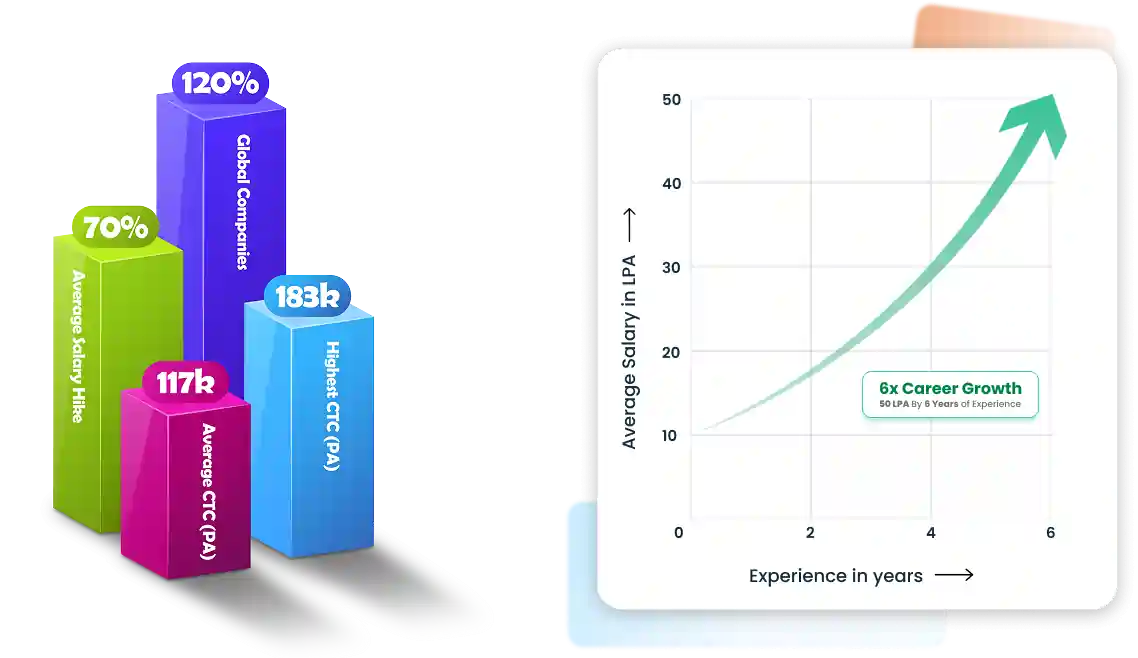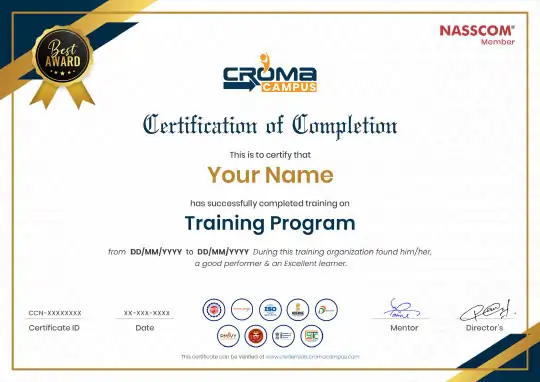Course Design By
Nasscom & Wipro
Starting at
Register Now
And Get
10%
OFF
Limited Time Offer*
Course Duration: 100 Hrs.
Live Project: 12
Course Price :
Presenting and Managing Data in Excel
Manage Workbook Options and Settings
Apply Custom Data Formats and Layouts
Create Advanced Formulas
MIS Reporting and Dashboards (Any 03 Dashboards)
Macros and VBA
Incorporating AI Into Excel
Combining ChatGPT With Microsoft Excel
SQL Fundamental
Advance SQL
Introduction to Power BI
Power BI Desktop
Power BI Data Transformation
Modelling with Power BI
Data Analysis Expressions (DAX)
Power BI Desktop Visualisations
Introduction to Power BI Dashboard and Data Insights
Direct Connectivity
Publishing and Sharing
Refreshing Datasets
Introduction to Data Preparation using Tableau
Data Connection with Tableau Desktop
Basic Visual Analytics
Calculations in Tableau
Advanced Visual Analytics
Level of Detail (LOD) Expressions in Tableau
Geographic Visualizations in Tableau
Advanced charts in Tableau
Dashboards and Stories
Get Industry Ready
Exploring Tableau Online
Introduction To Python
Python Keyword and Identiers
Introduction To Variables
Python Data Type
Control Structure & Flow
List
Tuple
Dictionary
Sets
Strings
Python Function, Modules and Packages
Decorator, Generator and Iterator
Python Exception Handling
Python File Handling
Memory management using python
Python Database Interaction
Reading an excel
Complete Understanding of OS Module of Python
Introduction to Machine Learning
Supervised Learning
Regression Algorithm
Classification Algorithm
Optimization Algorithm
Dimensionality Reduction
Unsupervised Learning
Association Rules Mining and Recommendation Systems
Reinforcement Learning
Time Series Analysis
Model Selection and Boosting
Introduction to Text Mining and NLP
Extracting, Cleaning and Preprocessing Text
Analyzing Sentence Structure
Text Classification - I
Getting Started with TensorFlow 2.0
Introduction to Deep Learning
Neural Networks
Convolution Neural Network
Image Processing and Computer Vision
Regional CNN
Introduction to RNN and GRU
RNN, LSTM
Faster Object Detection Algorithm
BERT Algorithm
Introduction to Cloud Computing
Amazon EC2 and Amazon EBS
Amazon Storage Services S3 (Simple Storage Services)
Cloud Watch & SNS
Scaling and Load Distribution in AWS
AWS VPC
Identity and Access Management Techniques (IAM)
Amazon Relational Database Service (RDS)
Multiple AWS Services and Managing the Resources' Lifecycle
AWS Architecture and Design
Migrating to Cloud & AWS
Router S3 DNS
Cloud Formation
Elastic Beanstalk
EFS / NFS (hands-on practice)
Hands-on practice on various Topics
Manage Azure identities and governance (15-20%)
Implement and Manage Storage (10-15%)
Deploy and Manage Azure Compute Resources (25-30%)
Configure and Manage Virtual Networking (30-35%)
Monitor and Back up Azure Resources (10-15%)
Course Design By
Nasscom & Wipro
Course Offered By
Croma Campus
You will get certificate after completion of program
Numpy
Python
Scipy
Tableau
Start your journey with the best IT
training experts in India.
50% Average Salary Hike
Course : Data Science
Course : Data Science
Course : Data Science
Course : AI
You will get certificate after
completion of program
You will get certificate after
completion of program
You will get certificate after
completion of program
Get a peek through the entire curriculum designed that ensures Placement Guidance
Course Design By
Course Offered By
Domain: Domain: CAB Services
Project Name:
For this project i would like to do Uber supply demand gap analysis. I hope everyone experienced of travelling in any of the cab services like uber. sometimes we may face the problem of cancellation by the driver or non-availability of cars. These are the problems faced by customers and it impact the business of Uber. If drivers cancel the request of riders or if cars are unavailable, Uber loses out on its revenue.
Domain: Domain: OTT Platform
Project Name:
The Internet Movie Database (IMDb) is an online database containing information and statistics about movies, TV shows and video games as well as actors, directors and other film industry professionals. This platform acts as a comprehensive resource for entertainment enthusiasts. Along with this, it provides information about the user reviews, ratings, cast and crew biographies. IMDB has proven to be an invaluable tool for navigating the vast world of entertainment.
Domain: Domain: Cricket Sports
Project Name:
Indian Premier League more popularly called IPL is a Cricket Tournament hoisted by the Cricket Board of India(BCCI). Players from different countries participate in IPL making it an exciting opportunity to entertain cricket lovers. IPL was established in 2008 when the first season of IPL was hoisted. We perform the EDA task to find the insights in data of a highest scorer player in the Indian team.
Tools & Technology Used
*Insights Displayed Are as Per Our Recorded Data
AI Engineer ₹8L - ₹12L
Machine Engineer ₹7L - ₹11L
AI Developer ₹7L - ₹10L
ML Engineer ₹8L - ₹13L
AI Analyst ₹6L - ₹9L
AI Consultant ₹8L - ₹12L
Deep Specialist ₹8L - ₹14L
AI Researcher ₹9L - ₹15L
NLP Engineer ₹8L - ₹12L
Vision Engineer ₹8L - ₹13L
Data Scientist ₹6L - ₹16L
AI Strategist ₹9L - ₹14L
Bot Developer ₹6L - ₹9L
AI Designer ₹6L - ₹9L
Chatbot Developer ₹6L - ₹9L
AI Trainer ₹5L - ₹8L
AI Modeler ₹6L - ₹9L
AI Modeler ₹6L - ₹9L
AI Trainer ₹5L - ₹8L
Chatbot Developer ₹6L - ₹9L
AI Designer ₹6L - ₹9L
Bot Developer ₹6L - ₹9L
AI Strategist ₹9L - ₹14L
Data Scientist ₹6L - ₹16L
Vision Engineer ₹8L - ₹13L
NLP Engineer ₹8L - ₹12L
AI Researcher ₹9L - ₹15L
Deep Specialist ₹8L - ₹14L
AI Consultant ₹8L - ₹12L
AI Analyst ₹6L - ₹9L
ML Engineer ₹8L - ₹13L
AI Developer ₹7L - ₹10L
Machine Engineer ₹7L - ₹11L
AI Engineer ₹8L - ₹12L
*Image for illustration only. Certificate subject to change.
Our Master program is exhaustive and this certificate is proof that you have taken a big leap in mastering the domain.
The knowledge and skill you've gained working on projects, simulation, case studies will set you ahead of competition.
Talk about it on Linkedin, Twitter, Facebook, boost your resume or frame it- tell your friend and colleagues about it.
Total Exam Submitted
Best of support with us
In this course, you will learn to use ML and DL's power to create robust AI solutions. Moreover, you will gain the skills that are essential for becoming a proficient artificial intelligence engineer. For example, you learn skills like ML, DL, neural networks, Python, etc. The main of this course is to help students acquire skills that are important for marketing themselves as AI engineers. After going through this program, you can easily get a job as a:
Thanks to the growing influence of AI in every industry and sector, a lot of opportunities for growth and progression are emerging in the market for professionals who pursue their careers in the AI industry. This is why organizations today are always looking for artificial intelligence experts and don't shy away to pay a good amount of money to AI experts for their services. Thus, you can guarantee yourself a phenomenal and highly fulfilling career by pursuing your career in the AI industry.
There is a constant increase in the number of firms adopting AI solutions in their organization with each passing year. The Artificial Intelligence Online Training program will help students develop skills that are essential for becoming proficient AI engineers. Moreover, you will learn about the impact of artificial intelligence on various industries and sectors and what are the advantages of using AI-based solutions.
![]() The project-based training will help students acquire skills essential for becoming competent AI engineers and getting placed in a renowned firm.
The project-based training will help students acquire skills essential for becoming competent AI engineers and getting placed in a renowned firm.
![]() After completing the artificial intelligence training program, you can easily get a job as an AI engineer in a renowned firm with a salary package of ₹5,00,000-₹21,00,000 PA.
After completing the artificial intelligence training program, you can easily get a job as an AI engineer in a renowned firm with a salary package of ₹5,00,000-₹21,00,000 PA.
![]() As per a survey, around 97 million job opportunities will be created in the AI industry worldwide in the coming years.
As per a survey, around 97 million job opportunities will be created in the AI industry worldwide in the coming years.
The aim of the artificial intelligence training program is to make students competent AI engineers by giving them quality education. Furthermore, you will learn to develop AI solutions for enhancing a firm's performance and increasing its profits. Things you will learn:
The main objective of artificial intelligence training is to give top-notch training to students that wish to make their career in the AI industry. The course is designed in such a way that a student can easily master all the concepts of AI. Moreover, the content of the course is developed in consultation with AI experts and keeping in mind the emerging demands of the artificial intelligence industry.
For Voice Call
+91-971 152 6942For Whatsapp Call & Chat
+91-9711526942

.png)

.png)
.png)




















.webp)

